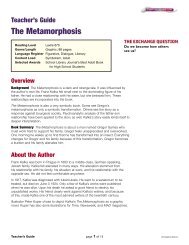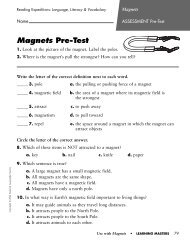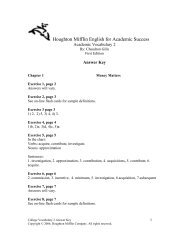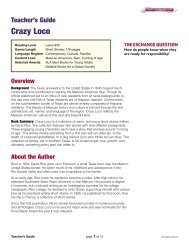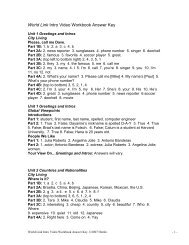Weaving It Together
Weaving It Together
Weaving It Together
Create successful ePaper yourself
Turn your PDF publications into a flip-book with our unique Google optimized e-Paper software.
UNIT 1<br />
CD 1<br />
Track 1<br />
Chapter<br />
1<br />
16 Unit 1<br />
Color Me Pink<br />
The readings and activities in this unit<br />
describe some hidden meanings associated<br />
with certain colors and numbers. Some<br />
of our beliefs about colors and numbers<br />
are thousands of years old. Here are some<br />
interesting facts about colors:<br />
• The room where people wait before<br />
appearing on TV shows is usually<br />
painted green because studies have<br />
shown that the color green helps people<br />
feel calm and relaxed.<br />
• Yellow is the hardest color for the eye to<br />
take in, and babies have been found to<br />
cry more in rooms painted yellow.<br />
• Pink has been shown to tranquilize<br />
people. Sports teams sometimes paint the<br />
locker room used by the opposing team<br />
pink so that the team will lose energy.<br />
Warm-Up<br />
Symbols<br />
You may start the lesson in one of these ways:<br />
• Have students look at the symbols<br />
on the unit opener page. The symbol<br />
on the upper left—a rod entwined<br />
by a snake with a mortar and pestle<br />
and prescription symbol—signifi es a<br />
pharmacy and medicine. The rod comes<br />
from the magic rod of Hermes, the Greek<br />
messenger of the gods. The symbol on<br />
the top right represents poison. The<br />
symbol on the lower left signifi es peace.<br />
The one on the lower right signifi es the<br />
passage of time. The symbols in the<br />
middle refer to recycling and e-mail.<br />
Have students think of some symbols<br />
that are used in their country. Then ask<br />
students to defi ne the word symbol. (A<br />
symbol is something that expresses an<br />
idea without using words.)<br />
• Ask students to stand up and form<br />
groups according to the main color of the<br />
clothing they are wearing that day. Point<br />
out different parts of the room where<br />
those wearing mostly green, blue, pink,<br />
etc., can gather. Ask students to discuss<br />
among themselves how the color they<br />
are wearing makes them feel. After a few<br />
minutes, invite the groups to share their<br />
fi ndings with the class.<br />
• Write the following color names on the<br />
board: black, white, green, yellow. Ask<br />
different students to tell the class about<br />
any special signifi cance each color has<br />
for people in their culture or for them<br />
personally. Compare the meanings each<br />
color has for different cultural groups<br />
and individuals.<br />
00238-X_006-073.indd 16 11/12/09 8:39 PM



